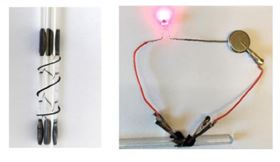 Optical photographs of printed 3D and 2D patterns of conductive ink (from left to right) in a 20-layered hollow cube, a hollow cylinder, a 5-layered serpentine pattern, and a 5-layered mesh structure.
Optical photographs of printed 3D and 2D patterns of conductive ink (from left to right) in a 20-layered hollow cube, a hollow cylinder, a 5-layered serpentine pattern, and a 5-layered mesh structure. Photograph of a printed serpentine pattern (left) and film wrapped around a glass rod (radius of 3 mm) with glowing LED light.
Photograph of a printed serpentine pattern (left) and film wrapped around a glass rod (radius of 3 mm) with glowing LED light.Researchers from KTH Royal Institute of Technology in Sweden have developed a conductive cellulose-based ink for printing three-dimensional (3D) stretchable wearable electronics that is cheaper and less energy intensive to produce [Jain et al., Applied Materials Today 30 (2023) 101703, https://doi.org/10.1016/j.apmt.2022.101703].
Bio-based electronics are of growing interest for wearable applications in energy storage, energy harvesting or biomedicine. But the conductive polymers, such as poly(3,4-ethylene dioxythiophene) (PEDOT) or poly(styrene sulfonate) (PSS), that are an essential component often require doping to increase conductivity, involving the use of harsh organic solvents or additives.
“[Our] motivation was to decrease the amount of conductive polymer in the ink because it is very expensive,” explains first author of the study, Karishma Jain.
Moreover, while nanocellulose is often used in bio-based inks to modulate mechanical properties, its preparation is energy intensive and time consuming. Instead, the ink developed by Lars Wågberg’s team based on PEDOT:PSS uses a form of cellulose known as dialcohol cellulose (DALC), where chemical modification opens the chain structure of the fibers.
“The use of macroscopic fibers is a crucial step since it simplifies the preparation of the ink, [avoiding] the energy intensive preparation of nanocellulose while still providing good rheological properties” adds Jain.
Like pearls on a necklace, polymer particles of PEDOT:PSS are supported by the DALC fibers, encouraging conformation change in the polymer chains and phase separation, which boost conductivity. When mixed with a plasticizer, the resulting DALC-PEDOT:PSS ink has the ideal viscoelastic properties for direct-ink writing in a 3D bioprinter.
“[The] ink formulation shows good conductive properties at less than 50 wt.% conducting polymer and without any harmful organic additives,” points out Jain.
Reducing the amount of conductive polymer needed reduces costs, while the absence of harmful organic species makes fabrication easier. Using the novel ink, the researchers printed water-stable, stretchable, highly conductive structures with excellent electrochemical performance for wearable supercapacitors and biopotential monitoring devices for electrocardiography (ECG) and electromyography (EMG) measurements. The researchers believe that the work represents the first extrudable, modified cellulose fiber based, 3D printable conductive bio-ink that does not require the nanofibrillation of cellulose.
“The material can be used in printed electronics,” says Jain, “[and] bio-based conductive coatings on implantable bioelectronic devices as an interface between the body and the implanted device.”
The team now hope to improve the adhesive and conductive properties of the composite to reduce production costs further.